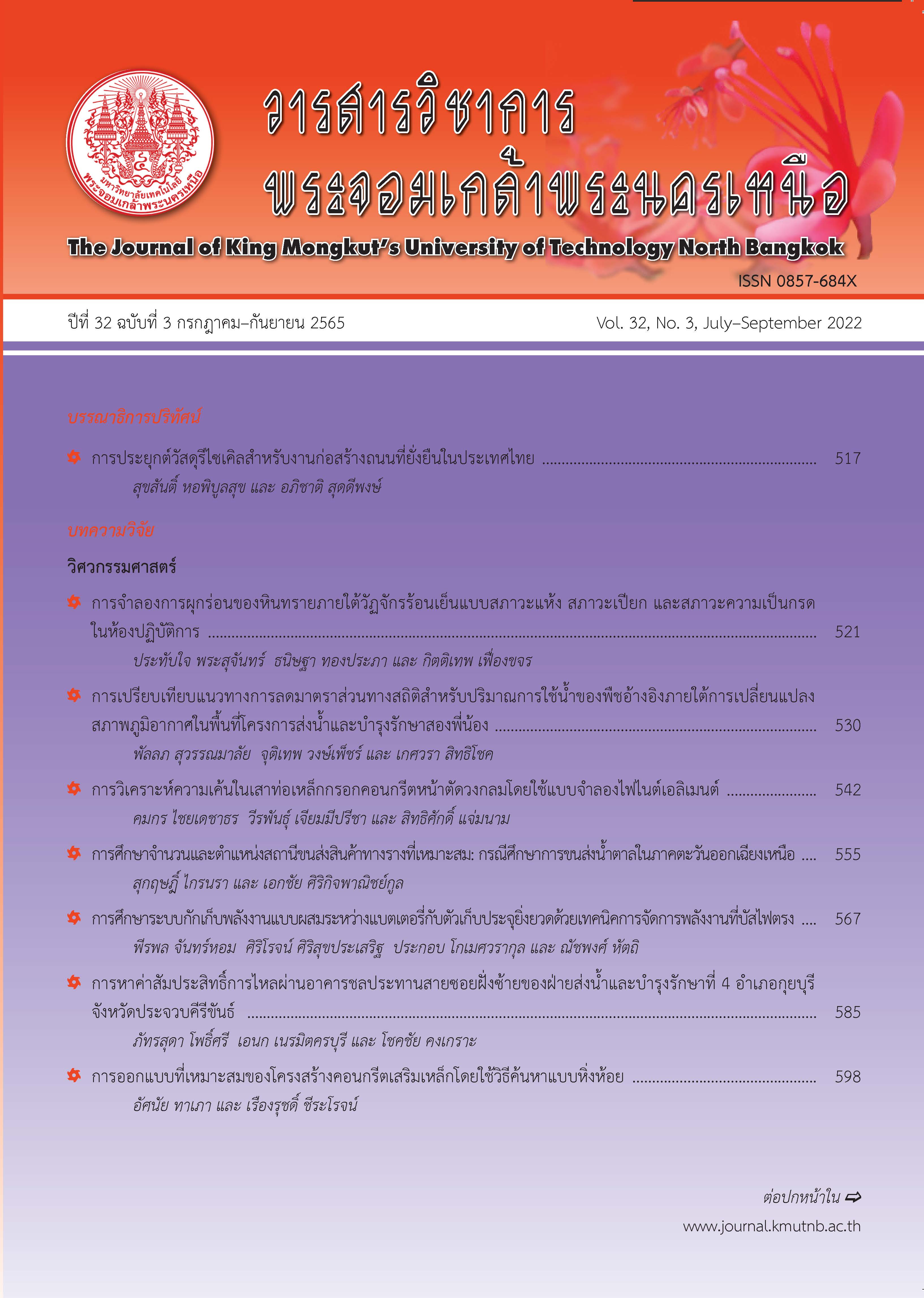Cu/CuO Doped TiO2 Photoanode for Photoelectrochemical Water Splitting
Main Article Content
Abstract
Hydrogen production from the photoelectrochemical water splitting (PEC) is one of promising alternative fuels attributable to its feature as a demand-driven energy supply and being environmentally benign. This research aims to develop the photoanode electrode consisting of TiO2 particles doped with a various amount of copper (Cu/TiO2) and PVDF on the ITO glass by spin coating technique. Photoelectrochemical properties of Cu/TiO2 films were characterized by Cyclic Voltammetry (CV) and Linear Sweep Voltammetry (LSV) under UV irradiation with the intensity of 15 mW/cm2. The results showed that the appropriate amount of PVDF is 20 wt% due to the film stability and the highest photocurrent after 10 full charge/discharge cycles. The TiO2 particles doped with copper in the range of 0.5–5 mol% (0.5–5 Cu/TiO2) exhibited the difference in physical and chemical properties associated with Cu content. Moreover, the 1.5Cu/TiO2 film was considered as a promising photoanode for the Oxygen Evolution Reaction (OER) because the photocurrent of the film was 16.2 μA/cm2 with applied voltage at 0.95 V vs. Ag/AgCl, which is 0.6 times greater than that of the prestige TiO2 film. Furthermore, the total generated current resulting from the photocurrent and an applying a voltage at 0.95 V was 0.23 mA/cm2.
Article Details

This work is licensed under a Creative Commons Attribution-NonCommercial-NoDerivatives 4.0 International License.
The articles published are the opinion of the author only. The author is responsible for any legal consequences. That may arise from that article.
References
L. R. Sheppard and R. Wuhrer, “TiO2-based homojunction photo-electrode for solar-driven water splitting,” International Journal of Hydrogen Energy, vol. 45, no. 16, pp. 9386–9396, 2020.
P. Nikolaidis and A. Poullikkas, “A comparative overview of hydrogen production processes,” Renewable and Sustainable Energy Reviews, vol. 67, pp. 597–611, 2017.
J. Joy, J. Mathew and S. C. George, “Nanomaterials for photoelectrochemical water splitting – review,” International Journal of Hydrogen Energy, vol. 43, pp. 4804–4817, 2018.
R. Singh and S. Dutta, “A review on H2 production through photocatalytic reactions using TiO2/TiO2-assisted catalysts,” Fuel, vol. 220, pp. 607–620, 2018.
S. Zheng, X.B. Cao, J. Wu, L.W. Zhu, and L. Gu, “Preparation of hierarchical CuO@TiO2 nanowire film and its application in photoelectrochemical water splitting,” Transactions of Nonferrous Metals Society of China, vol. 26, no. 8, pp. 2094–2101, 2016.
L. Yao, W. Wang, L. Wang, Y. Liang, J. Fu, and H. Shi, “Chemical bath deposition synthesis of TiO2/Cu2O core/shell nanowire arrays with enhanced photoelectrochemical water splitting for H2 evolution and photostability,” International Journal of Hydrogen Energy, vol. 43, no. 33, pp. 15907–15917, 2018.
Z. Li, J. Liu, D. Wang, Y. Gao, and J. Shen, “Cu2O/Cu/ TiO2 nanotube Ohmic heterojunction arrays with enhanced photocatalytic hydrogen production activity,” International Journal of Hydrogen Energy, vol. 37, no. 8, pp. 6431–6437, 2012.
Y. Yang, D. Xu, Q. Wu, and P. Diao, “Cu2O/CuO bilayered composite as a high-efficiency photocathode for photoelectrochemical hydrogen evolution reaction,” Scientific Reports, vol. 44, no. 39, pp. 21351–21378, 2019.
J. Li, X. Jin, R. Li, Y. Zhao, X. Wang, X. Liu, and H. Jiao, “Copper oxide nanowires for efficient photoelectrochemical water splitting,” Applied Catalysis B: Environmental, vol. 240, pp. 1–8, 2019.
P. Ngaotrakanwiwat, P. Heawphet, and P. Rangsunvigit, “Enhancement of photoelectrochemical cathodic protection of copper in marine cndition by Cu-doped TiO2,” Catalysts, vol. 10, no. 2, pp. 146, 2020.
J. Inderherbergh, “Polyvinylidene fluoride (PVDF) appearance, general properties and processing,” Ferroelectrics, vol. 115, no. 4, pp. 295–302, 1991.
P. Atkins, J. D. Paula, and J. Keeler, Atkins' Physical Chemistry, 11th ed. Oxford University press, 2018.
J. Wu, C. Li, X. Zhao, Q. Wu, X. Qi, X. Chen, T. Hu, and Y. Cao, “Photocatalytic oxidation of gas-phase Hg0 by CuO/TiO2,” Applied Catalysis B: Environmental, vol. 176, pp. 559–569, 2015.
L. Wang, K. Gupta, J. B.M. Goodall, J. A. Darr, and K. B. Holt, “In situ spectroscopic monitoring of CO2 reduction at copper oxide electrode,” Faraday Discuss, vol. 197, pp. 517–532, 2017.
U. Shaislamov, K. Krishnamoorthy, S. J. Kim, S. Choi, W. Chun, and H.-J. Lee, “Growth of CuO/ZnO nanobranched photoelectrode with enhanced stability for solar hydrogen generation,” Journal of Nanoscience and Nanotechnology, vol. 16, no. 10, pp. 10541–10547, 2016.
I. Ganesh, P. P. Kumar, I. Annapoorna, J. M. Sumliner, M. Ramakrishna, N. Y. Hebalkar, G. Padmanabham, and G. Sundararajan, “Preparation and characterization of Cu-doped TiO2 materials for electrochemical, photoelectrochemical, and photocatalytic applications,” Applied Surface Science, vol. 293, pp. 229–247, 2014.
J. M. Kum, S. H. Yoo, G. Ali, and S. O. Cho, “Photocatalytic hydrogen production over CuO and TiO2 nanoparticles mixture,” International Journal of Hydrogen Energy, vol. 38, no. 31, pp. 13541–13546, 2013.
M. Janczarek and E. Kowalska, “On the origin of enhanced photocatalytic activity of coppermodified titania in the oxidative reaction systems,” Catalysts, vol. 7, no. 11, pp. 317, 2017.
V. Madhavi, P. Kondaiah, M. Ghosh, and G. M. Rao, “Hydrogen plasma-treated 1D/3D TiO2 nanorod array photoanode for efficient photoelectrochemical water splitting,” Ceramics International, vol. 46, no. 11, pp. 17791–17799, 2020.
T. Sh. Atabaev, D. H. Lee, and N. H. Hong, “Fabrication of TiO2/CuO photoelectrode with enhanced solar water splitting activity,” Functional Materials Letters, vol. 10, no. 6, pp. 1750084, 2017.

